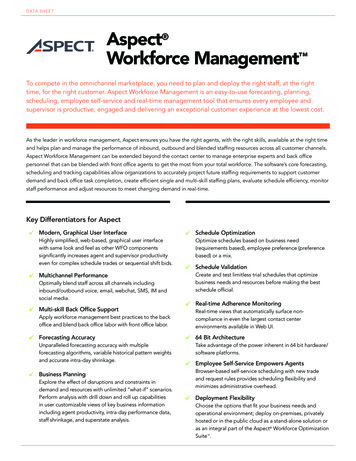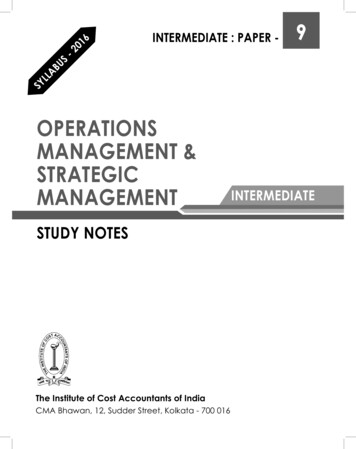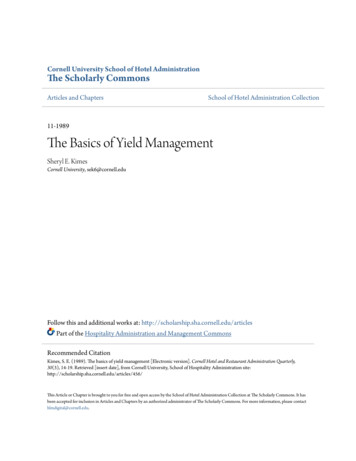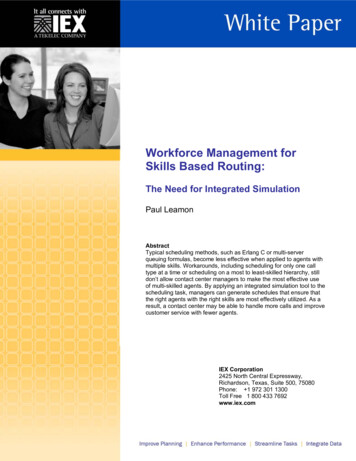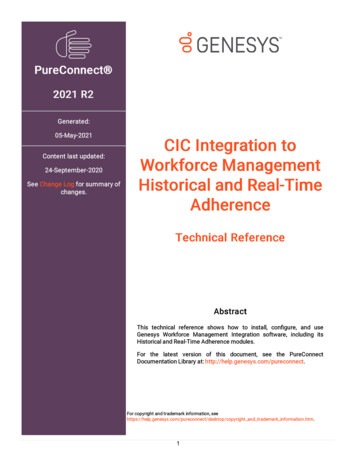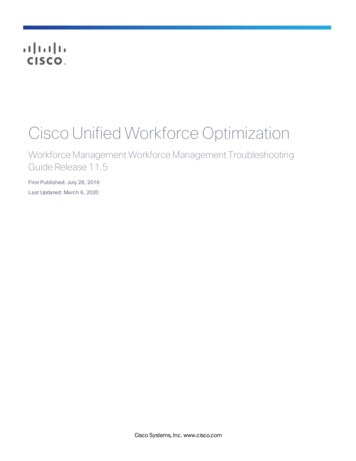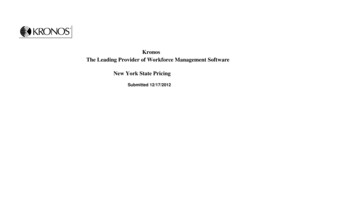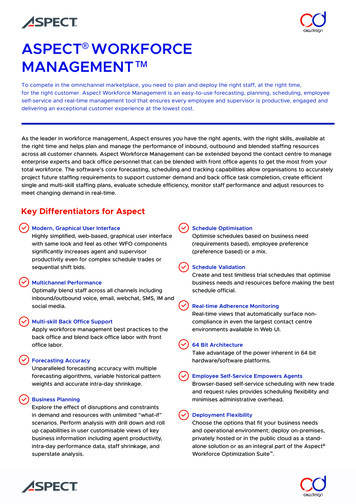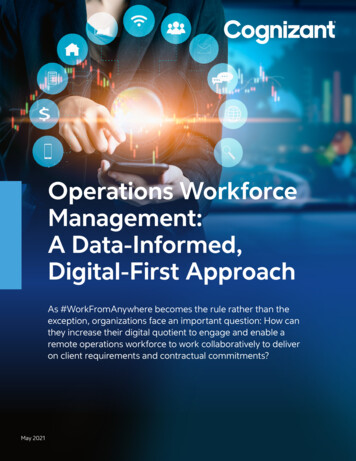
Transcription
Operations WorkforceManagement:A Data-Informed,Digital-First ApproachAs #WorkFromAnywhere becomes the rule rather than theexception, organizations face an important question: How canthey increase their digital quotient to engage and enable aremote operations workforce to work collaboratively to deliveron client requirements and contractual commitments?May 2021
Executive SummaryThe pace of change over the last 12 months has far exceededthat of the previous few years. One key development is that#WFA is replacing traditional ways of working. Also, hybridwork models with select staff in offices and the rest basedanywhere is becoming the norm.With operations dispersed across many locations, organizations are challenged to gainreal-time insights on staff productivity. Aggregating individual-, team- and department-levelproductivity data has always been difficult, but the pandemic with its resultant disruption inthe operating models has compounded the issue.Fluctuating business volumes also make it difficult to address variations in workloads andback-office capabilities across teams and sites. Plus, today’s highly distributed processingenvironment makes it tough to deliver in a consistent fashion. Returning to normaloperating levels is an uphill task, especially due to decades of underinvestment in digitalsolutions that, if properly installed, could have provided access to operational healthindicators in a post-pandemic scenario.So, what can organizations do to remain competitive amid the seismic shift to WFA?Focusing on “interconnected behaviors” or “work patterns” of operations staff is a goodstarting place. New-age digital solutions can generate such insights to help leaders makeinformed decisions to reimagine how operations are delivered. As organizations digitallyrewire to improve their ways of working, enhancing workforce engagement becomeseasier by providing avenues for work and scheduling process optimization in distributedenvironments.We believe a holistic, data-led, human-centric approach — one that infuses a processmining-like focus to understand work patterns — should be used in conjunction withother digital initiatives. This white paper describes applying a workforce management(WFM) approach with a unique blend of digital and human imperatives: hyper-utilization,gamification, hyper-automation, commercial innovation and change management.2 / Operations Workforce Management: A Data-Informed, Digital-First Approach
Operations Workforce Management: A Data-Informed, Digital-First Approach/ 3
Understanding work patterns in a changed worldThe initial phase of the pandemic was a period of unprecedentedurgency concerning operations enablement. Millions of workers acrossindustries moved toward a remote-working/work-from-home (WFH)operating model. Organizations provisioned hardware and collaborationsoftware at breakneck speed as they prepared for the long haul.As organizations enabled their operations workforce, a lack of visibility on key performance indicators andwork patterns hampered remote delivery. Competing priorities in a WFH scenario where staff juggleddaily production targets with domestic workloads caused significant upheaval in workforce management.Operations supervisors struggled to understand the performance of their teams across the dimensions ofavailability, ability, variability and engagement. Figure 1 depicts the key aspects of each dimension that weremissing in “the new normal.”Gaining such insights on work patterns was nextto impossible in the absence of effective digitalsolutions. Microsoft Excel trackers and traditionaltime-tracking software could not be scaled up to thecomplex needs of operations managers, which oftengo beyond productivity commitments and requirereal-time decision-making on key business priorities.A case in point: Operations leadership at a leadingglobal financial services firm that is a client of oursnearly overnight had to transition from aggregatingsuch insights to manage a 3,000-plus staff workforceacross six captive sites to grappling with practically3,000-plus delivery sites.Our analysis of work patterns of over 10,000 globaloperations staff supporting engagements acrossindustries generated numerous insights pre- andpost-COVID (see Figure 2), including:Missing workforce managementingredientsAvailability Number of stafflogged dailyCapacity for workloadLoad balancingopportunitiesRight skills for rightworkAbility Variability Interregional/interdepartmentalBots/peopleTime trends (daily/monthly)Productive capacityTenured staff/newjoinersPeak performancelevelsConsistencyEngagement Staff morale andmotivationOvertimeWork/life balanceConsequencemanagementGamificationFigure 1 There was an increase in the average number of hours spent on work systems by back-office staff. The average increase in productive hours of approximately 8-12% post-COVID compared with preCOVID was consistent across industry sectors. The increase could be attributed to industry-specific and industry-agnostic factors, based onindustry dynamics and processing environments.4 / Operations Workforce Management: A Data-Informed, Digital-First Approach
Pandemic productivity propellantsIndustry-Specific FactorsIndustry-Agnostic FactorsInsurance Insurance: Increase in claims notifications,premium grace periods, renewals extensionsa,bBanking &Financial Services Financial services: COVID-19-induced marketvolatility, increase in trading volumesc,dHealthcare Healthcare: Greater admissions to hospitals,increase in provider support Life SciencesLife sciences: Disruptions in normal clinicaltrial flowse Remote working/WFH distractions Limited access to SMEs Connectivity/low bandwidth Unavailability of dual monitors Hardware recovery timeframe Collaboration e-next-normal.abFigure 2We believe digital investments that generate insights on employee productivity can help organizationsscale up their hybrid operating models, and that enterprises should institutionalize associated workforcemanagement practices to support the changes. Gartner illustrates the heightened need for employeeproductivity monitoring as part of the “innovation trigger” phase within its “Hype Cycle for Human CapitalManagement Technology, 2020” research report (See Figure 3).1ExpectationsGartner Hype Cycle for Human Capital Management Technology, 2020Freelance Management SystemsVoice of the EmployeePaaS (Platform as a Service) in HCMHyperautomation in HCMVirtual Assistants in RecruitingNext-Gen Talent AssessmentsEmployee Experience Tech(EX Tech)AI in Talent AcquisitionEmployee Productivity MonitoringVirtual Assistants in HCMD&I in HCMLearning Experience PlatformsFlexible Earned Waged AccessInternal Talent MarketplaceNext-Gen WFMUnified Multicountry PayrollDigital Adoption SolutionsContinuous Employee Performance ManagementMachine Learning in HCMMidoffice and Back-Office WFOEmployee WellnessEmployee Recognition and Reward SystemWorkforce Planning and ModelingDigital HR Document ManagementVR/AR Applications inCorporate LearningSkills OntologiesCoaching/MentoringApplicationsHR Application in FrameworksBlockchain in HCMInnovationTriggerPeak of InflatedExpectationsCompensation Allocation for Line ManagersOnboardingCandidate Relationship Managementand Recruitment MarketingVideo RecruitingTalent AnalyticsIntegrated HR Service ManagementTrough ofDisillusionmentSlope ofEnlightenmentAs of July 2020Plateau ofProductivitytimePlateau will be reached:less than 2 yearsDistributedcloud2-5 years5-10 yearsmore than 10 yearsobsolete before plateauFigure 2Source: GartnerFigure 3Operations Workforce Management: A Data-Informed, Digital-First Approach/ 5
Hyper-utilization: Making every second countProductivity is often a relative measure. For organizations drivingefficiency improvement programs, the goal has always been tounderstand employee productivity using historical trends and variancesacross individuals, teams, sites and locations.Increasing the productive hours quotient as a measure of total work hours has traditionally yielded an initialuplift in productivity. In the past, focusing on productive hours would have sufficed for most organizations.However, in a world disrupted by the pandemic and facing top-line pressures, accelerating margin/bottomline enhancement is now a key goal. This means that as incremental back-office capacity has turned scarce,the shift to productive output has become utterly essential.Many organizations started accelerating the drive to increase the productive output quotient of their alreadystretched back-office staff. This was, however, not easy to achieve given the distributed spread.We believe it is in these environments that organizations can reap significant benefits by combining processmining and WFM across operations flows (see Figure 4, next page). Process mining helps generate data ondifferent ways or paths followed by staff (spread across sites/locations/teams) to complete a transaction, inorder to unearth the optimal “happy path.” Analysts can compare the different paths to reduce variations andprovide visibility to staff to follow the optimized path. WFM incrementally provides organizations with an abilityto inculcate optimized behaviors while proceeding down the happy path.We believe digital investments that generate insights onemployee productivity can help organizationsscale up their hybrid operating models, and that enterprisesshould institutionalize associated workforcemanagement practices to support the changes.6 / Operations Workforce Management: A Data-Informed, Digital-First Approach
The hyper-utilization equationHyper-utilizationFocusIdentify the optimal “happy path”while completing transactionsInculcate optimal behaviors/ workpatterns while processing the“happy path”Processes/value chainsProcessors/workforceProcess mining tools/digitaloperations analyticsWFM tools/data-led WFMApplied ToDigital InterventionsFigure 4Optimized behaviors within processing value chains can help to increase productive output withoutincrementally adding capacity, thereby augmenting hyper-utilization. But how can the real impact of suchoptimized behaviors be measured to gain visibility into tangible outcomes such as increased processingcapacity? The answer lies in leveraging additional metrics such as “occupancy” for tracking productiveoutput. This should be a key component of any hyper-utilization drive.Occupancy provides a measure of “user occupancy” calculated from average handling time, input volumesand productive time. Already prevalent in call-center environments, occupancy can be used extensivelyto generate actionable insights on work patterns across back office (non-voice/data) operations as well, toensure that every second of the happy path processing is productive. These actionable insights are based on: Productive work output Incremental workload that staff can take on without disrupting their schedules Instances where productive output fell short of required levels Inter-/intra-performance variations Opportunities for cross-skilling to help achieve productive output Matching supply side and demand side dynamicsGamification: Influencing employee behaviorsWith greater visibility on critical work pattern behaviors,benchmarking performance levels across segments enablesorganizations to design HR interventions — such as customizedincentive plans — to help boost back-office efficiency.Operations Workforce Management: A Data-Informed, Digital-First Approach / 7
Playing the gameTraditionalApproachVS.Gamification LedPush staff to do higher productionUse game-led encouragement to staff to do moreSet productivity target for monthOffer incentives above target performanceDiscourage unplanned leavesReward good behaviorApply overtime in case of high volumesGenerate capacity within teamFigure 5While traditional models focused more on “push” strategies, newer behavior-led models focus on the “pull” factor(see Figure 5) to facilitate increased engagement and motivation and thus improve productive work output.Introducing gamification helps to positively influence work pattern behaviors, just as it does by generating interestin children during early education endeavors.In a distributed working model, the lack of physical contact and other traditional bonding mechanisms providedby office environments hampered employee engagement and efficiency. Gamification provides avenues forengagement through cooperative competition for individuals, groups and teams to drive toward a common goal.We believe the combination of gamification and WFM is a potent means of driving productivity without dilutingthe employee well-being proposition. It takes the focus away from consequence management and provides amechanism for more positive feedback, driven by: Peers (who are part of the same team/group/department) intent on improving an individual’s way ofworking to help improve the group’s performance in the game-led delivery model Leadership/supervisors who can optimize their time to actively encourage employees to be facilitators ofproductivity — such as skill enhancements, coaching interventions and alleviating organizational barriersto increase productive work output HR teams that recognize accomplishments, leading to higher employee engagement scores8 / Operations Workforce Management: A Data-Informed, Digital-First Approach
Quick TakeGamification-Led BehavioralChange at a Global FinancialServices FirmOur operations transformation approach combines gamification with other levers such asWFM and lean management to drive lasting behavioral changes.For a global financial services client, we applied this approach to establish a “self-driven”culture for efficiency improvements. A performance matrix based on historical datagenerated via effective WFM helped benchmark staff production levels (i.e., highest output)across months. We then introduced gamification with a robust points-based productiveoutput tracking and reporting mechanism for healthy competition among individuals andteams. We also created a slabs-based incentive model as a pull mechanism to providestaff with clear visibility on KPIs, inducing them to improve not only individually but alsocollectively for the team’s benefit.For this client, a yearlong operations tournament led to a 21% uplift in the productive outputacross individuals/teams. A nearly 95% reduction in the cost to achieve was attained asthe initiative established a self-funding model for benefits realization without interventionsexternal to the team. A sense of collective achievement, greater rigor and enhancedperformance scores led to improved employee engagement scores.Operations Workforce Management: A Data-Informed, Digital-First Approach/ 9
Hyper-automation: How WFM accelerates processimprovementIntelligent automation has evolved significantly. The bot lifecycle — from development and release into production — until recently required niche technicalskills and efforts. With the ease-of-use evolution of robotic process automation(RPA) tools, citizen development models2 gained prominence and scale.As armies of business/operations users took on the mantle of building bots as part of the “self-design, developand manage” movement, organizations needed visibility on the efforts spent by such power/super users andother citizen developers on bot development while delivering on their daily transaction processing targets.Additionally, hybrid staff (bots humans) meant that while a process value chain benefits from efficiencyuplift provided by bots, the human scope could slow end-to-end processing. This would defeat the objectiveestablished at the outset to improve operational efficiency via an increase in automation.With the growing maturity of digital solutions such as WFM tools, accelerating the automation agenda becameeasier. Insights on work pattern behaviors of segmented back-office staff can enable organizations to: Drive dynamic capacity management based on an increase in visibility around the effort staff spend onsoftware bot development compared with efforts spent on daily production volumes. Staff can be dynamicallyallocated to focus on critical transaction processing activities with clear visibility on the efforts required. Monitor bot utilization using WFM tools and take important decisions to increase automation-relatedinvestments. Realize the true potential of employees by obtaining insights on the end-to-end processing value chainand their contribution to overall efficiency objectives. Redesign operations by applying usage and process-level insights provided by WFM tools. Suchdata can help identify automation opportunities without the need for traditional shadowing techniquesenabling directed efforts in a WFH scenario. This is gaining significant interest as organizations drive hyperautomation initiatives remotely.In our experience, however, a WFM initiative cannot be driven in isolation without streamlining workforceactivities. This requires strategic and tactical automation for various activities as part of the WFM initiative itself(see Figure 6, next page).In our experience, however, a WFM initiative cannot bedriven in isolation without streamlining workforce activities.10 / Operations Workforce Management: A Data-Informed, Digital-First Approach
Key WFM activities that should be explored for automationCustomized executivemanagement WFMdashboard creation anddistributionIntegration with HRsystems for seamlessupdate of onboarding/offboarding/time sheets, etc.Integration of WFMtools with transactionprocessing systems(workflows) for optimizingproductive outputArchivingWFMartifactsfor auditsStandardWFM userconfigurationsand ongoingadministrationactivities onWFM toolsLatent capacitycalculationsrequiring datasanitizingfor largepopulationsWorkflowsfor workallocation andcollaboration,to replaceemail-basedflowsFigure 6How superior WFM reinforces commercialcommitments and innovationWFM enables third-party operations partners to adhere to contractualcommitments. Service providers can leverage WFM data for timesheetmanagement, as the data captured automatically from these tools isproving to be the most credible source. Service providers can alsoremain in compliance with their commercial agreements by improvingwork patterns such as adherence to the required number of contractedhours, especially in the case of time and materials (T&M) contracts.Organizations that want to improve WFM in their retained operations are generally wary of the inherentrisks of any such project. Service providers may fail to deliver on their contractual commitments orproposed productivity-linked benefits due to a lack of visibility on the client landscape and the missing WFMingredients. Pricing/commercial innovations therefore become key to delivering the value proposition byincentivizing both the client and service provider to drive improvements in work patterns. Clients can drivechanges in work patterns to reduce their costs to achieve the benefits, while service providers can benefitfrom the nonlinear revenue potential.Operations Workforce Management: A Data-Informed, Digital-First Approach / 11
A WFM offering can be reinforced for both the client and the service provider in the following ways: Traditional linear pricing: This is the most widely used pricing model to date. It includes linear paymentsbased on WFM software licenses and fixed bid/time and material-based payments for implementation/advisory efforts. Simple in structure, this model eliminates the com
solutions that, if properly installed, could have provided access to operational health indicators in a post-pandemic scenario. So, what can organizations do to remain competitive amid the seismic shift to WFA? Focusing on “interconnected behaviors” or “wor
